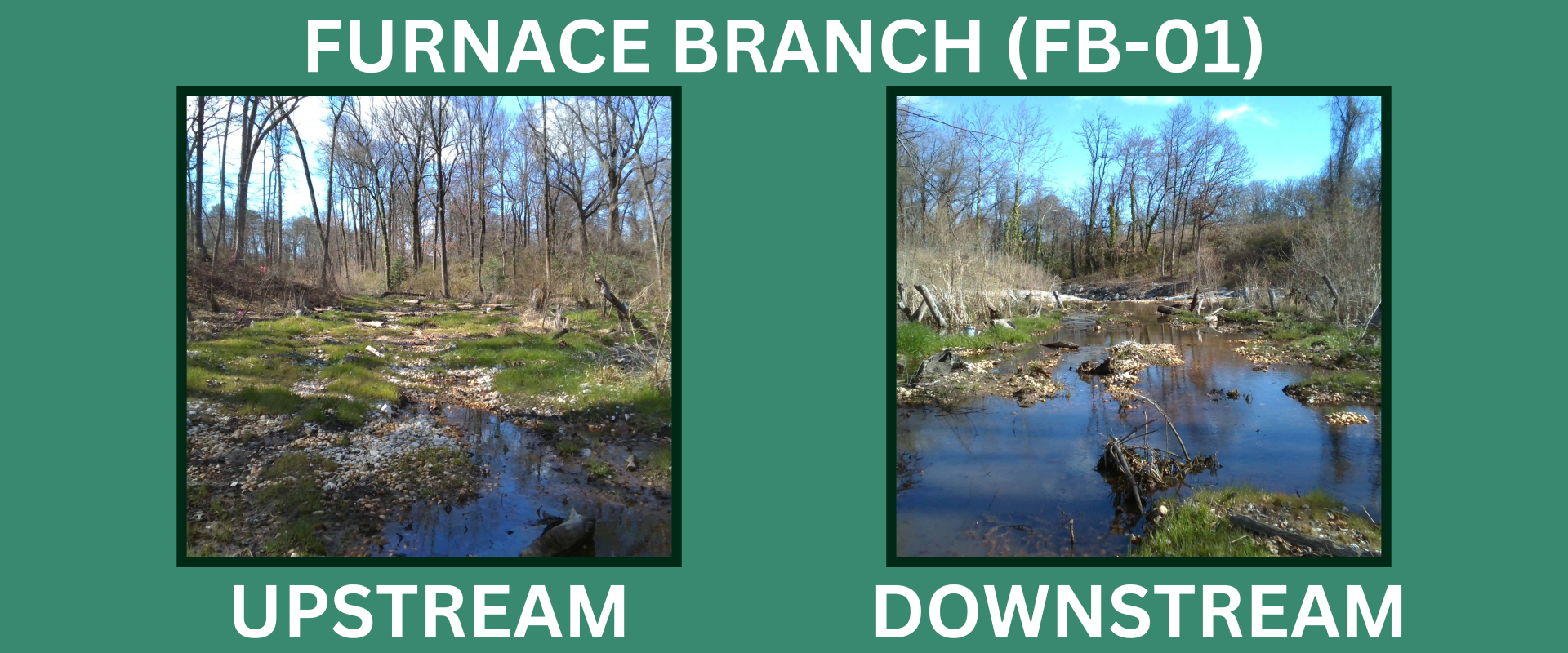
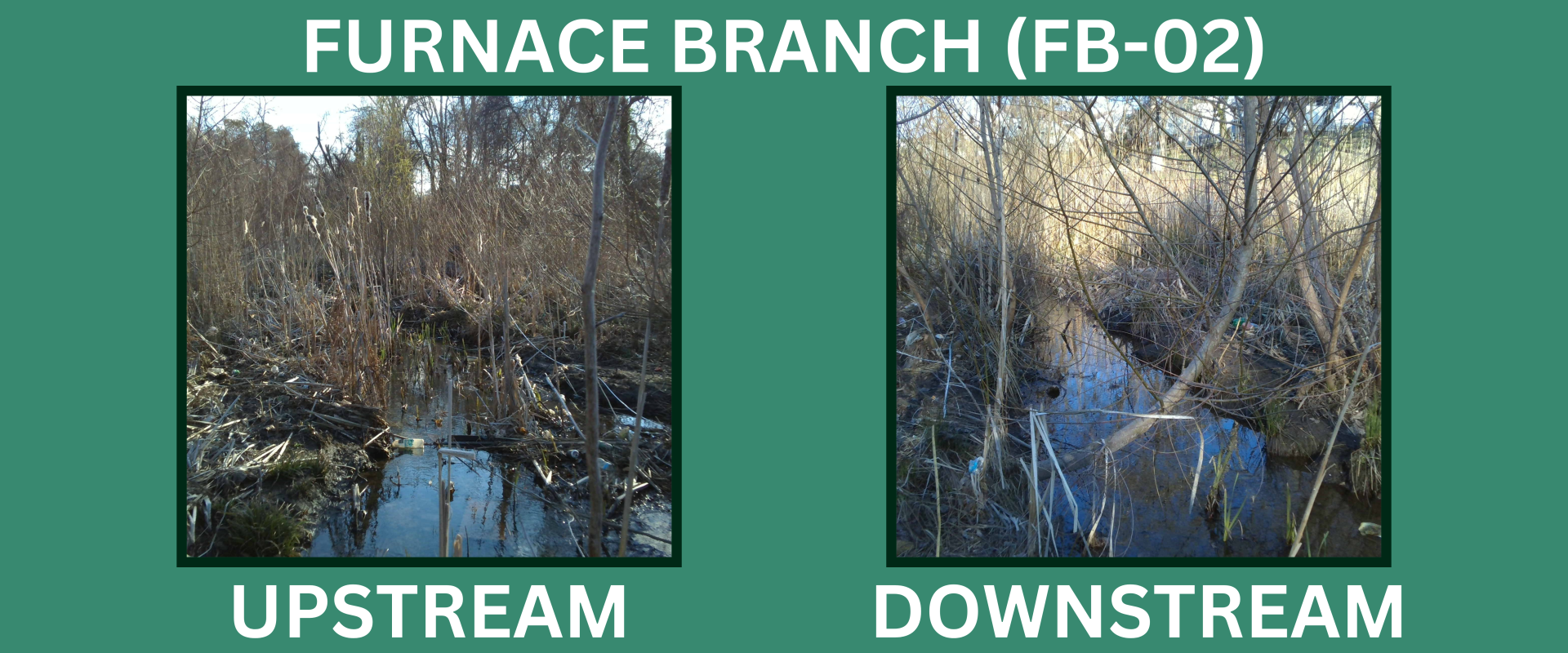
| Site FB-01 | |||
|---|---|---|---|
| Time Frame | BIBI (Condition) | FIBI (Condition)a | RBP (Condition) |
| 2024 Results | 2.43 (Poor) | 3.33 (Fair) | 132 (Partially Supporting) |
| Cumulative Average (2016-2024) | 2.06 (Poor) | 3.00 (Fair) | 121 (Partially Supporting) |
| 3-year Running Average | 2.52 (Poor) | 3.00 (Fair) | 134 (Partially Supporting) |
a) Fish data was only collected in 2016, 2022, and 2024..
| Site FB-02 | |||
|---|---|---|---|
| Time Frame | BIBI (Condition) | FIBI (Condition)a | RBP (Condition) |
| 2024 Results | 2.71 (Poor) | 3.33 (Fair) | 124 (Supporting) |
| Cumulative Average (2016-2024) | 2.06 (Poor) | 2.44 (Poor) | 105 (Partially Supporting) |
| 3-year Running Average | 2.43 (Poor) | 2.44 (Poor) | 140 (Supporting) |
a) Fish data was only collected in 2016, 2022, and 2024.
Site FB-01: Located downstream of the former concrete channel, this site received a BIBI score of 2.43 (Poor) in 2024. BIBI scores have seen a slight increase since restoration, as pre-restoration ratings were consistently “Very Poor,” while post-restoration ratings have all been “Poor.” Post-restoration benthic communities have been dominated by true flies. Caddisflies have not been present in the samples from this site since 2022.
FB-01 Summary of Insects Collected by Sample Year:
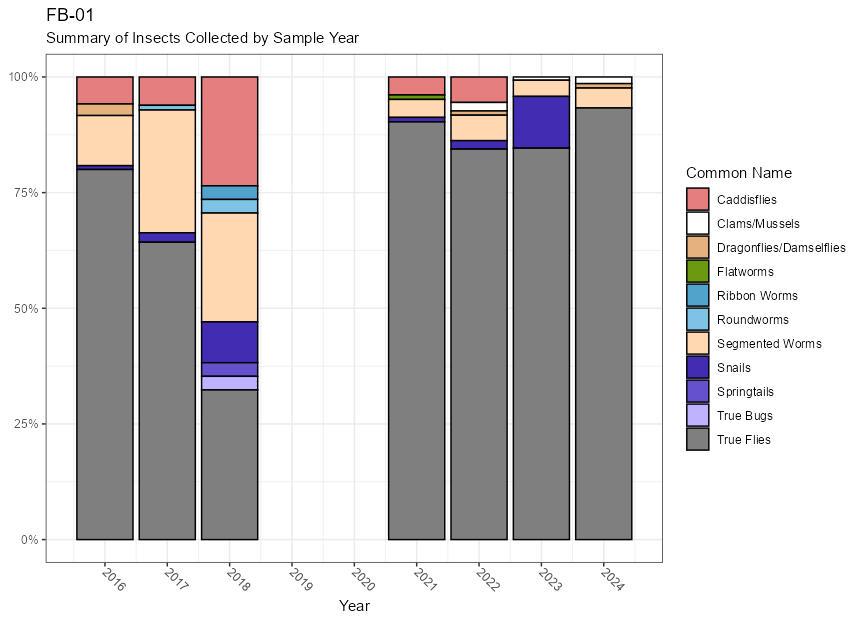
Site FB-02: This site is located within the former concrete floodway. In 2024, this site received a BIBI score of 2.71 (Poor), the highest score this site has received since monitoring began in 2016. Post-restoration ratings have all been “Poor,” while pre-restoration ratings were consistently “Very Poor.” Similar to sampling years prior to restoration, the 2024 sample was dominated by true flies. The proportion of dragonflies, however, continued a year-over-year increase.
FB-02 Summary of Insects Collected by Sample Year:
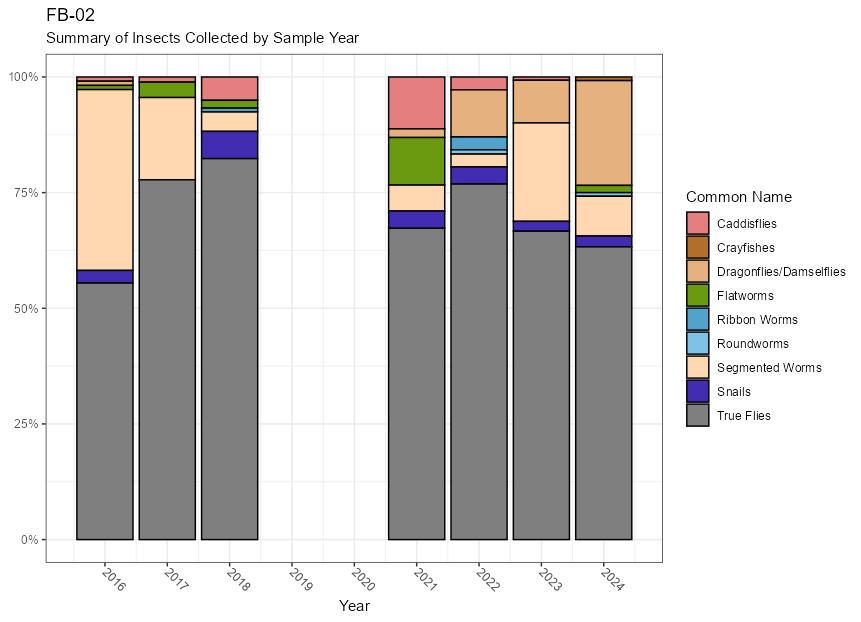
Site FB-01: Fish sampling has occurred three times at this site, in 2016, 2022, and 2024. In 2016, the lone pre-restoration sampling year, the FIBI score was 2.67 (Poor) and only nine individual fish representing three species were observed. In contrast, the 2022 post-restoration sample resulted in a FIBI score of 3.00 (Fair), with 554 individual fish representing five species collected. In 2024, the FIBI improved to 3.33 (Fair), as 845 fish from six different species were present in the sample. Creek chubsucker (Erimyzon oblongus) was the dominant species in 2024, and brown bullhead (Ameiurus nebulosus) was observed at the site for the first time. Notably, this is the only program site where both white sucker (Catostomus commersonii) and creek chubsucker have been found together.
FB-01 Summary of Fish Collected by Sample Year:
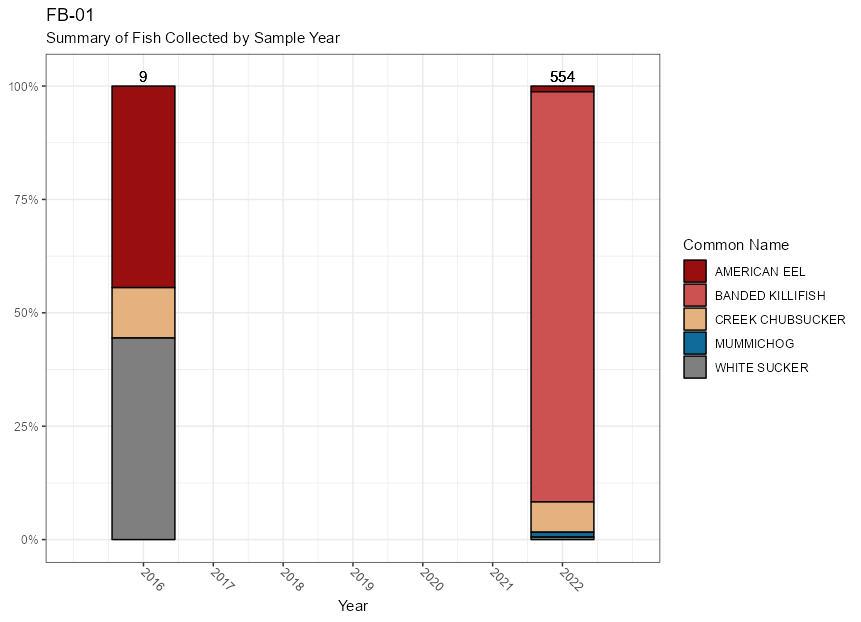
Site FB-02: Fish sampling has occurred three times at this site, in 2016, 2022, and 2024. In 2016, no fish were found during sampling so the site automatically received a FIBI score of 1.00 (Very Poor). The former concrete channel offered virtually no habitat available for fish. Additionally, the downstream end of the concrete channel was perched approximately 5 feet above the natural channel downstream, a significant barrier to fish movement in this system. Any fish that did attempt to inhabit this reach would likely be flushed out of the system during storm flow conditions, where velocities regularly reached 4 to 5 feet per second even during modest rain events. In 2022, after removal of the concrete channel and further restoration activities, 150 individual fish representing six species were found in 2022, earning the site a score of 3.00 and a “Fair” rating. Like the downstream site at FB-01, the FIBI score continued to improve in 2024 to 3.33 (Fair). 130 fish from five species were present in the 2024 sample. Similar FIBI scores and species overlap between FB-02 and FB-01 indicate that the restoration project has been successful in reconnecting these once disconnected reaches.
FB-02 Summary of Fish Collected by Sample Year:

Site FB-01: The RBP score for this site in 2024 was 132 (Supporting), an increase from the previous year’s score. The cumulative average score for this site is 121 (Partially Supporting) and the three-year average is 134 (Supporting).
Site FB-02: Because this site was formerly a concrete floodway channel, the RBP habitat condition was previously rated as Non-Supporting. However, with the implementation of the restoration and removal of the concrete channel, this site has seen RBP scores markedly improve. The site received a score of 124 (Partially Supporting) in 2024. The cumulative average score for this site is 105 (Partially Supporting) and the three-year average is 140 (Supporting).
Site FB-01: The cross section installed for this site in 2006 could not be recovered. A new monumented section was installed in 2016 and future measurements will allow tracking of this site’s stability. An examination of the photos taken in 2006 versus 2016 provide some qualitative support that the channel had widened between 2006 and 2016. A cross section measurement has not been performed post-restoration as the stream channel is still adjusting to the restoration. Future work, which is planned to begin in 2024, will seek to quantify the maintenance of stability in the restored reach. Due to lack of data prior to and following restoration, as well as the extensive reconfiguration of the channel during restoration, no cross sectional overlay diagram is available at this time.
Site FB-02: Prior to restoration, the site was relatively stable as the concrete acted as a bedrock control. A cross section measurement has not been performed since restoration work was completed, as the stream channel is still adjusting to the restoration. Future work, which is planned to begin in 2024, will seek to quantify the maintenance of stability in the restored reach. Due to the extensive reconfiguration of the channel during restoration and lack of post-restoration survey data, no cross sectional overlay diagram is available at this time.
| FB-01 | |||
|---|---|---|---|
| Year | BIBI (Condition) | FIBI (Condition) | RPB (Condition) |
| 2016 | 1.86 (VP) | --- | 114 (PS) |
| 2017 | 1.86 (VP) | --- | 104 (PS) |
| 2018 | 1.00 (VP) | --- | 90 (NS) |
| 2019 | --- | --- | --- |
| 2020 | --- | --- | --- |
| 2021 | 2.14 (P) | --- | 137 (S) |
| 2022 | 2.43 (P) | 3.00 (F) | 147 (S) |
| 2023 | 2.71 (P) | -- | 123 (PS) |
2024 | 2.43 (P) | 3.33 (F) | 132 (S) |
| FB-02 | |||
|---|---|---|---|
| Year | BIBI (Condition) | FIBI (Condition) | RPB (Condition) |
| 2016 | 1.86 (VP) | --- | 71 (NS) |
| 2017 | 1.29 (VP) | --- | 64 (NS) |
| 2018 | 1.57 (VP) | --- | 67 (NS) |
| 2019 | --- | --- | --- |
| 2020 | --- | --- | --- |
| 2021 | 2.43 (P) | --- | 115 (PS) |
| 2022 | 2.43 (P) | 3.00 (F) | 151 (C) |
| 2023 | 2.14 (P) | -- | 144 (S) |
2024 | 2.71 (P) | 3.33 (F) | 124 (S) |
| Station Summary | ||||||
|---|---|---|---|---|---|---|
| Average BIBI (SD)a | 3-Year Average BIBI (SD)a | Average RPB (SD)a | 3-Year Average RBP (SD)a | Average FIBI (SD)b | 3-Year FIBI Average (SD)b | |
| FB-01 | 2.06 (0.56) | 2.52 (0.16) | 121 (20) | 134 (12) | 3.00 (0.33) | 3.00 (0.33) |
| FB-02 | 2.06 (0.51) | 2.43 (0.29) | 105 (37) | 140 (14) | 2.44 (1.26) | 2.44 (1.26) |
a) No data is available for 2019 or 2020.
b) Fish data collected in 2016, 2022, and 2024.
SD = Standard Deviation

